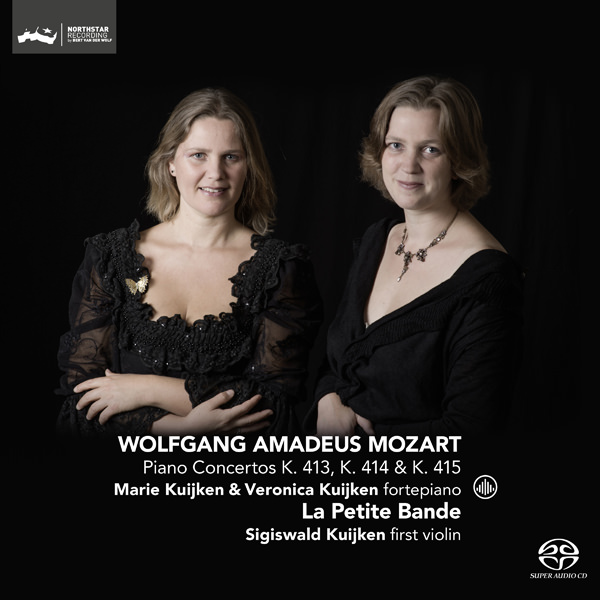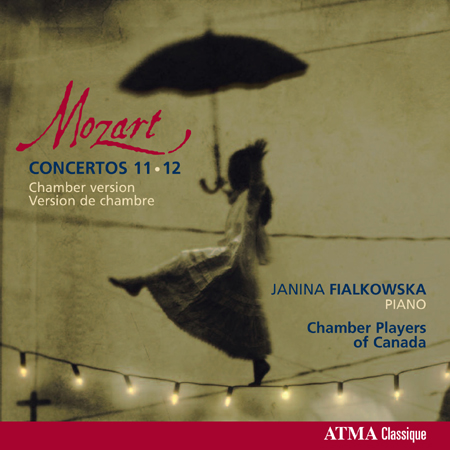
Wolfgang Amadeus Mozart – Piano Concertos KV 413, 414 & 415 – Marie & Veronica Kuijken, La Petite Bande (2017)
Digital eXtreme Definition FLAC Stereo (tracks) 24-bit/352,8 kHz | Time – 01:14:32 minutes | 4,08 GB | Genre: Classical
Studio Master, Official Digital Download – Source: spiritofturtle.com | Booklet, Front Cover | © Challenge Records
Recorded: Kapel Holland College, Leuven Belgium, 15-17 May 2016
Sigiswald Kuijken: Mozart conceived the 3 piano-concerti KV 414, 413 and 415 in 1782, one year after he had settled in Vienna as a more or less free-lance musician. From onset, his idea was to get these works (KV 414, 413 and 415) published; he obviously expected a positive response from the public, not only on the financial level but also as a composer and piano virtuoso. In order to enhance the attraction for his publication, he decided to write these concertos in such a way that they could be performed not only with full orchestra (i.e. strings and winds), but also with a reduced accompaniment of only string quartet. Clearly, Mozart did not consider this strategic starting point as an artistic limitation, but rather as a challenge: in fact, already the score without the wind parts should leave nothing to be desired. This resulted in a very careful and beautiful string writing, matching the solo part in the most effective and intimate way. The wind parts were then conceived to accentuate and “colour” certain passages in the accompaniment with even more depth.
Although Mozart in his announcements and the print of these concerti always mentions the “normal” composition of the string quartet (2 violins, viola and violoncello), I took the liberty to replace the violoncello by a double bass in our performances and our recording of these concertos. My reason was purely musical. Looking and listening to these works, we find a clear difference concerning their string-bass writing compared with Mozart’s own quartets for violin, viola, violoncello and piano, or also his trios for violin, violoncello and piano.
In these piano concertos the string bass is only playing the essential bass-line of the whole texture, thus very often doubling in simplified way the soloist’s left hand. Therefore, in fact this so called “violoncello” part shows exactly what the usual “basso” parts show in orchestral works or generally in the more conventional divertimento-style: offering and strengthening the (highly necessary) fundamental bass on which the whole of the construction is resting. So replacing the violoncello by a double bass in this reduced version of these concertos seems to me an obvious choice.
Tracklist:
Wolfgang Amadeus Mozart (1756-1791)
Piano Concerto No.11 in F Major, K.413/387a
[1] Allegro 10:12
[2] Larghetto 7:33
[3] Tempo di Minuetto 5:41
Piano Concerto No.13 in C Major, K.415/387b
[4] Allegro 10:44
[5] Andante 7:23
[6] Rondeau. Allegro 8:20
Piano Concerto No.12 in A Major, K.414/385p
[7] Allegro 10:00
[8] Andante 7:45
[9] Rondeau. Allegretto 6:49
Personnel:
Marie Kuijken, fortepiano #1-3
Veronica Kuijken, fortepiano #4-9
La Petite Bande
Sigiswald Kuijken, first violin
Sara Kuijken, second violin
Marleen Thiers, viola
Elise Christiaens, double bass
Download:
mqs.link_MzartPianCncertsKV413414415MarieVernicaKuijkenLaPetiteBande2017DXD352824.part1.rar
mqs.link_MzartPianCncertsKV413414415MarieVernicaKuijkenLaPetiteBande2017DXD352824.part2.rar
mqs.link_MzartPianCncertsKV413414415MarieVernicaKuijkenLaPetiteBande2017DXD352824.part3.rar
mqs.link_MzartPianCncertsKV413414415MarieVernicaKuijkenLaPetiteBande2017DXD352824.part4.rar
mqs.link_MzartPianCncertsKV413414415MarieVernicaKuijkenLaPetiteBande2017DXD352824.part5.rar




















![Johann Sebastian Bach - Matthaus-Passion BWV 244 - La Petite Bande, Sigiswald Kuijken (2010) [nativeDSDmusic DSF DSD64/2.82MHz] Johann Sebastian Bach - Matthaus-Passion BWV 244 - La Petite Bande, Sigiswald Kuijken (2010) [nativeDSDmusic DSF DSD64/2.82MHz]](https://getimg.link/images/imgimgimg/uploads/2017/03/tojgCOP.jpg)
![Glenn Gould - The Complete Columbia Album Collection (2015 Remastered Edition) [Qobuz FLAC 24bit/44,1kHz] Glenn Gould - The Complete Columbia Album Collection (2015 Remastered Edition) [Qobuz FLAC 24bit/44,1kHz]](https://getimg.link/images/imgimgimg/uploads/2017/07/2bHwfbA.jpg)
![Combattimento Consort Amsterdam, Jan Willem de Vriend - Handel: Concerti grossi Op. 3 (2005) [nativeDSDmusic DSF DSD64/2.82MHz] Combattimento Consort Amsterdam, Jan Willem de Vriend - Handel: Concerti grossi Op. 3 (2005) [nativeDSDmusic DSF DSD64/2.82MHz]](https://getimg.link/images/imgimgimg/uploads/2018/12/1IGUAzV.jpg)
![La Petite Bande, Sigiswald Kuijken - J.S. Bach: Motets (2006) [nativeDSDmusic DSF DSD64/2.82MHz] La Petite Bande, Sigiswald Kuijken - J.S. Bach: Motets (2006) [nativeDSDmusic DSF DSD64/2.82MHz]](https://getimg.link/images/imgimgimg/uploads/2018/08/YUInbCl.jpg)
![La Petite Bande, Sigiswald Kuijken - J.S. Bach: St. John Passion, BWV 245 (2012) [nativeDSDmusic DSF DSD64/2.82MHz] La Petite Bande, Sigiswald Kuijken - J.S. Bach: St. John Passion, BWV 245 (2012) [nativeDSDmusic DSF DSD64/2.82MHz]](https://getimg.link/images/imgimgimg/uploads/2018/08/QDwT4TN.jpg)
![Kuijken Piano Quartet - Mozart: Piano Quartets K.493 & K.478 (2017) [FLAC 5.1 Surround 24bit/352,8kHz + FLAC Stereo 24bit/352,8kHz] Kuijken Piano Quartet - Mozart: Piano Quartets K.493 & K.478 (2017) [FLAC 5.1 Surround 24bit/352,8kHz + FLAC Stereo 24bit/352,8kHz]](https://getimg.link/images/imgimgimg/uploads/2019/01/rEkRSHv.jpg)
![Wolfgang Amadeus Mozart - Sonatas for four hands - Marie & Veronica Kuijken (2011) [HDTracks FLAC 24bit/96kHz] Wolfgang Amadeus Mozart - Sonatas for four hands - Marie & Veronica Kuijken (2011) [HDTracks FLAC 24bit/96kHz]](https://getimg.link/images/imgimgimg/uploads/2017/02/4cL5ThH.jpg)
![George Frideric Handel - Concerti grossi op. 6 HWV 319-330 - Combattimento Consort Amsterdam, Jan Willem de Vriend (2012) [FLAC 24bit/352,8kHz + 24bit/176,4kHz] George Frideric Handel - Concerti grossi op. 6 HWV 319-330 - Combattimento Consort Amsterdam, Jan Willem de Vriend (2012) [FLAC 24bit/352,8kHz + 24bit/176,4kHz]](https://getimg.link/images/imgimgimg/uploads/2017/06/xzc6lPQ.jpg)
![Hannes Minnaar, Netherlands Symphony Orchestra, Jan Willem de Vriend - Beethoven: Piano Concerto No. 3 (2017) [FLAC 5.1 Surround 24bit/352,8kHz + FLAC Stereo 24bit/352,8kHz] Hannes Minnaar, Netherlands Symphony Orchestra, Jan Willem de Vriend - Beethoven: Piano Concerto No. 3 (2017) [FLAC 5.1 Surround 24bit/352,8kHz + FLAC Stereo 24bit/352,8kHz]](https://getimg.link/images/imgimgimg/uploads/2019/01/NDbhUa6.jpg)
![Rachel Podger, Gary Cooper - Mozart: Complete Sonatas for Keyboard & Violin (2004-09) [DSF DSD64/2.82MHz] Rachel Podger, Gary Cooper - Mozart: Complete Sonatas for Keyboard & Violin (2004-09) [DSF DSD64/2.82MHz]](https://getimg.link/images/imgimgimg/uploads/2018/08/CtydJ1g.png)
![Howard Shelley, London Mozart Players - Kozeluch: Piano Concertos Nos 1, 5 & 6 (2016) [Hyperion FLAC 24bit/96kHz] Howard Shelley, London Mozart Players - Kozeluch: Piano Concertos Nos 1, 5 & 6 (2016) [Hyperion FLAC 24bit/96kHz]](https://getimg.link/images/imgimgimg/uploads/2019/01/m7LdDI0.jpg)
![VA - Christmas with St John’s (2016) [FLAC 24bit/96kHz] VA - Christmas with St John’s (2016) [FLAC 24bit/96kHz]](https://getimg.link/images/imgimgimg/uploads/2018/04/PrP9mrX.jpg)
![Rachel Podger, Jane Rogers - Mozart, Haydn: Duo Sonatas (2011) [DSF DSD64/2.82MHz] Rachel Podger, Jane Rogers - Mozart, Haydn: Duo Sonatas (2011) [DSF DSD64/2.82MHz]](https://getimg.link/images/imgimgimg/uploads/2019/01/VkhN8EH.jpg)
![Kuijken Quartet - Beethoven: String Quartets Op. 59, String Quintet Op. 29 (2011) [nativeDSDmusic DSF DSD64/2.82MHz] Kuijken Quartet - Beethoven: String Quartets Op. 59, String Quintet Op. 29 (2011) [nativeDSDmusic DSF DSD64/2.82MHz]](https://getimg.link/images/imgimgimg/uploads/2018/12/q31K4Ql.jpg)
